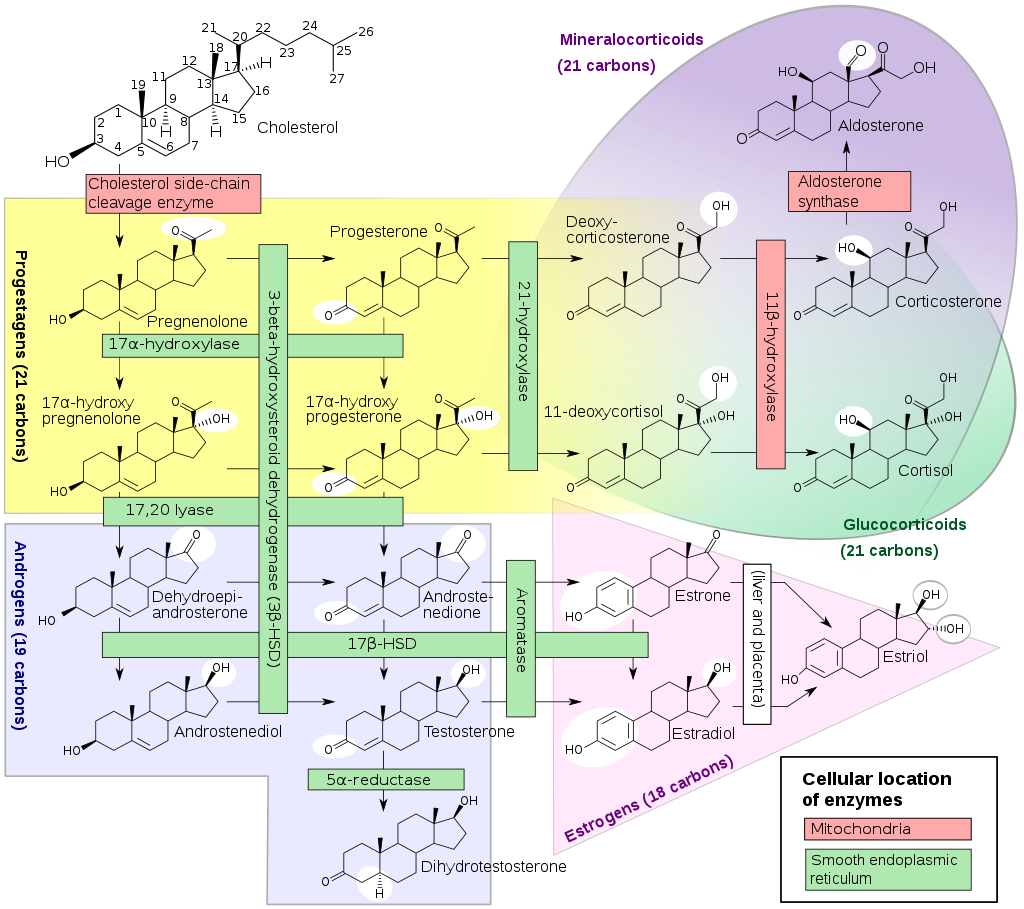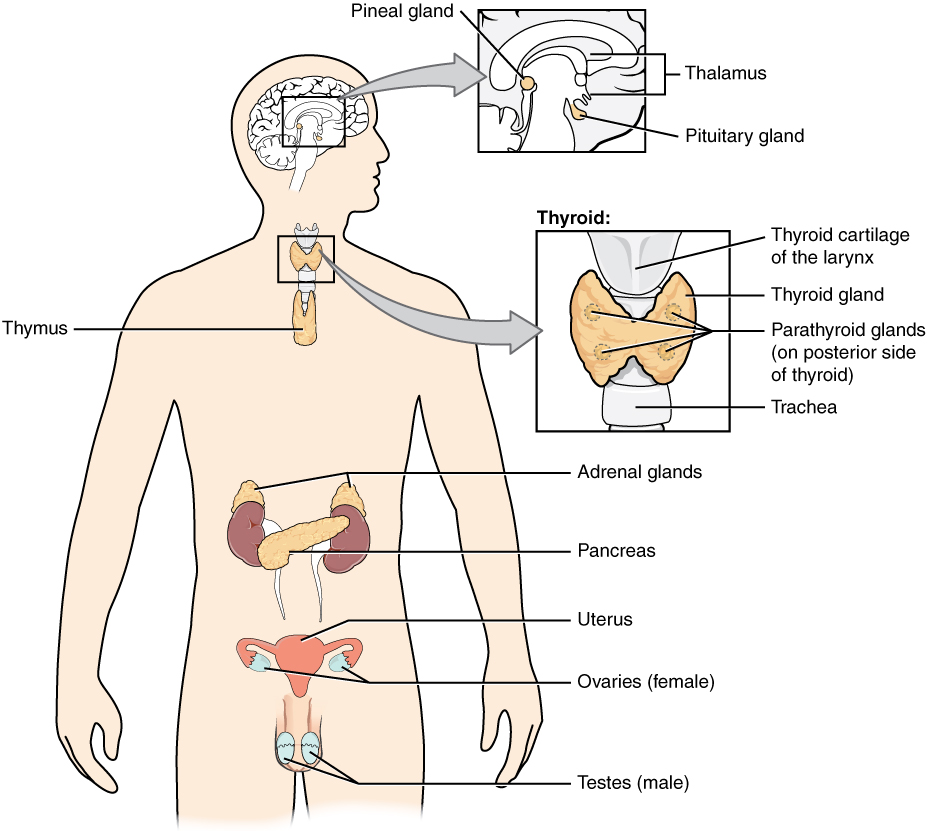9.2 Introduction to the Endocrine System
Created by CK-12 Foundation/Adapted by Christine Miller

Your body the chemist
Your endocrine system is constantly making hormones that will regulate every body system that makes up you! The endocrine system is an adept chemist; by making a chain of modifications to the steroid cortisol, your body can make a whole host of other hormones at a moment’s notice.
Overview of the Endocrine System
The endocrine system is a system of glands called endocrine glands that release chemical messenger molecules into the bloodstream. The messenger molecules of the endocrine system are called endocrine hormones. Other glands of the body, including sweat glands and salivary glands, also secrete substances, but not into the bloodstream. Instead, they secrete them through ducts that carry them to nearby body surfaces. These other glands are not part of the endocrine system. Instead, they are called exocrine glands.
Endocrine hormones act slowly compared with the rapid transmission of electrical messages in the nervous system. Endocrine hormones must travel through the bloodstream to the cells they affect, and this takes time. On the other hand, because endocrine hormones are released into the bloodstream, they travel throughout the body wherever blood flows. As a result, endocrine hormones may affect many cells and have body-wide effects. The effects of endocrine hormones are also longer lasting than the effects of nervous system messages. Endocrine hormones may cause effects that last for days, weeks, or even months.
Glands of the Endocrine System
The major glands of the endocrine system are shown in Figure 9.2.2. The glands in the figure are described briefly in the rest of this section. Refer to the figure as you read about the glands in the following text.

All of the glands labelled in Figure 9.2.2 are part of the endocrine system. Note that the ovary and testis are the only endocrine glands that differ in males and females.
Pituitary Gland
The pituitary gland is located at the base of the brain. It is controlled by the nervous system via the brain structure called the hypothalamus, to which it is connected by a thin stalk. The pituitary gland consists of two lobes, called the anterior (front) lobe and posterior (back) lobe. The posterior lobe stores and secretes hormones synthesized by the hypothalamus. The anterior lobe synthesizes and secretes its own endocrine hormones, also under the influence of the hypothalamus. One endocrine hormone secreted by the pituitary gland is growth hormone, which stimulates cells throughout the body to synthesize proteins and divide. Most of the other endocrine hormones secreted by the pituitary gland control other endocrine glands. Generally, these hormones direct the other glands to secrete either more or less of their hormones, which is why the pituitary gland is often referred to as the “master gland” of the endocrine system.
Remaining Glands of the Endocrine System
Each of the other glands of the endocrine system is summarized below. Several of these endocrine glands are also discussed in greater detail in other concepts in this chapter.
- The thyroid gland is a large gland in the neck. Thyroid hormones (such as thyroxine) increase the rate of metabolism in cells throughout the body. They control how quickly cells use energy and make proteins.
- The four parathyroid glands are located in the neck behind the thyroid gland. Parathyroid hormone helps keep the level of calcium in the blood within a narrow range. It stimulates bone cells to dissolve calcium and release it into the blood.
- The pineal gland is a tiny gland located near the center of the brain. It secretes the hormone melatonin, which controls the sleep-wake cycle and several other processes. The production of melatonin is stimulated by darkness and inhibited by light. Cells in the retina of the eye detect light and send signals to a structure in the brain called the suprachiasmatic nucleus (SCN). Nerve fibres carry the signals from the SCN to the pineal gland via the autonomic nervous system.
- The pancreas is located near the stomach. Its endocrine hormones include insulin and glucagon, which work together to control the level of glucose in the blood. The pancreas also secretes digestive enzymes into the small intestine.
- The two adrenal glands are located above the kidneys. Adrenal glands secrete several different endocrine hormones, including the hormone adrenaline, which is involved in the fight-or-flight response. Other endocrine hormones secreted by the adrenal glands have a variety of functions. The hormone aldosterone, for example, helps regulate the balance of minerals in the body. The hormone cortisol is also an adrenal gland hormone.
- The gonads include the ovaries in females and the testes in males. They secrete sex hormones, including testosterone (in males) and estrogen and progesterone (in females). These hormones control sexual maturation during puberty and the production of gametes (sperm or egg cells) by the gonads after sexual maturation.
- The thymus gland is located in front of the heart. It is the site where immune system cells, called T cells, mature. T cells are critical to the adaptive immune system, in which the body adapts to specific pathogens.
Endocrine System Disorders
Diseases of the endocrine system are relatively common. An endocrine system disease usually involves the secretion of too much or not enough of a hormone. When too much hormone is secreted, the condition is called hypersecretion. When not enough hormone is secreted, the condition is called hyposecretion.
Hypersecretion and Hyposecretion

Hypersecretion by an endocrine gland is often caused by a tumor. A tumor of the pituitary gland, for example, can cause hypersecretion of growth hormone. If this occurs during childhood and goes untreated, it results in very long arms and legs, and an abnormally tall stature by adulthood (see Figure 9.2.3). This condition is commonly known as gigantism.
Hyposecretion by an endocrine gland is often caused by destruction of the hormone-secreting cells of the gland. As a result, not enough of the hormone is secreted. An example of this is type 1 diabetes, in which the body’s own immune system attacks and destroys cells of the pancreas that secrete insulin. This type of diabetes is generally treated with frequent injections of insulin.
Hormone Resistance
In some cases, an endocrine gland secretes a normal amount of hormone, but target cells do not respond normally to it. This may occur because target cells have become resistant to the hormone. An example of this type of endocrine disorder is type 2 diabetes. In type 2 diabetes, body cells do not respond to normal amounts of insulin. As a result, cells do not take up glucose from the blood, leading to high blood glucose levels. Insulin may or may not be needed to treat type 2 diabetes. Instead, it may be treated with lifestyle changes and non-insulin medications.
9.2 Summary
- The endocrine system is a system of glands that release chemical messenger molecules called hormones into the bloodstream. Other glands, called exocrine glands, release substances onto nearby body surfaces through ducts. Endocrine hormones travel more slowly than nerve impulses, which are the body’s other way of sending messages. The effects of endocrine hormones, however, may be much longer lasting.
- The pituitary gland is the master gland of the endocrine system. Most of the hormones it produces control other endocrine glands. These glands include the thyroid gland, parathyroid glands, pineal gland, pancreas, adrenal glands, gonads (testes and ovaries), and thymus gland.
- Diseases of the endocrine system are relatively common. An endocrine disease usually involves hypersecretion or hyposecretion of a hormone. Hypersecretion is frequently caused by a tumor. Hyposecretion is often caused by destruction of hormone-secreting cells by the body’s own immune system.
9.2 Review Questions
- What is the endocrine system? What is its general function?
-
-
- Describe the role of the pituitary gland in the endocrine system.
- List three endocrine glands other than the pituitary gland. Identify their functions.
- Which endocrine gland has an important function in the immune system? What is that function?
- Name an endocrine disorder in which too much of a hormone is produced.
- What are two reasons people with diabetes might have signs and symptoms of inadequate insulin?
- Besides location, what is the main difference between the anterior lobe of the pituitary and the posterior lobe of the pituitary?
9.2 Explore More
How do your hormones work? – Emma Bryce, TED-Ed, 2018.
What is congenital adrenal hyperplasia (CAH), Bijniervereniging NVACP, 2014.
Cynthia Kenyon: Experiments that hint of longer lives, TED, 2011.
Attributions
Figure 9.2.1
Steroidogenesis.svg by David Richfield (User:Slashme) and Mikael Häggström on Wikimedia Commons is used under a CC BY-SA 3.0 (https://creativecommons.org/licenses/by-sa/3.0/deed.en) [Derived from previous version by Hoffmeier and Settersr]
Figure 9.2.2
1801_The_Endocrine_System by OpenStax College on Wikimedia Commons is used under a CC BY 3.0 (https://creativecommons.org/licenses/by/3.0/deed.en) license.
Figure 9.2.3
MartinVanBurenBates by unknown on Wikimedia Commons is believed to be in the public domain.
References
Betts, J. G., Young, K.A., Wise, J.A., Johnson, E., Poe, B., Kruse, D.H., Korol, O., Johnson, J.E., Womble, M., DeSaix, P. (2013, June 19). Figure 17.2 Endocrine system [digital image]. In Anatomy and Physiology (Section 17.1). OpenStax. https://openstax.org/books/anatomy-and-physiology/pages/17-1-an-overview-of-the-endocrine-system
Bijniervereniging NVACP. (2014, October 11). What is congenital adrenal hyperplasia (CAH)? YouTube. https://www.youtube.com/watch?v=-gNj5KoWLhE&feature=youtu.be
Häggström M, Richfield D (2014). Diagram of the pathways of human steroidogenesis. WikiJournal of Medicine 1 (1). DOI:10.15347/wjm/2014.005. ISSN 20024436 [Derived from previous version by Hoffmeier and Settersr]
TED. (2011, November 17). Cynthia Kenyon: Experiments that hint of longer lives. YouTube. https://www.youtube.com/watch?v=V48M5j-6zdE&feature=youtu.be
TED-Ed. (2018, June 21). How do your hormones work? – Emma Bryce. YouTube. https://www.youtube.com/watch?v=-SPRPkLoKp8&feature=youtu.be
The body system which acts as a chemical messenger system comprising feedback loops of the hormones released by internal glands of an organism directly into the circulatory system, regulating distant target organs. In humans, the major endocrine glands are the thyroid gland and the adrenal glands.
Gland such as a sweat gland, salivary gland, or mammary gland that secretes a substance into a duct that carries the secretion to the outside of the body.
The master gland of the endocrine system that secretes many hormones, the majority of which regulate other endocrine glands.
The central nervous system organ inside the skull that is the control center of the nervous system.
The highly complex body system of an animal that coordinates its actions and sensory information by transmitting signals to and from different parts of its body. The nervous system detects environmental changes that impact the body, then works in tandem with the endocrine system to respond to such events.
A part of the brain that secretes hormones and connects the brain with the endocrine system.
The front lobe of the pituitary gland that synthesizes and secretes pituitary hormones.
The back lobe of the pituitary gland that stores and secretes hypothalamic hormones.
A hormone is a signaling molecule produced by glands in multicellular organisms that target distant organs to regulate physiology and behavior.
A large endocrine gland in the neck whose hormones control the rate of cellular metabolism and help maintain calcium homeostasis.
One of a pair of small endocrine glands in the neck that secretes hormones that regulate blood calcium.
A body fluid in humans and other animals that delivers necessary substances such as nutrients and oxygen to the cells and transports metabolic waste products away from those same cells. In vertebrates, it is composed of blood cells suspended in blood plasma.
An endocrine gland that secretes the hormone melatonin, which regulates the sleep-wake cycle.
A hormone that regulates the sleep–wake cycle, primarily released by the pineal gland.
A long, flat gland that sits tucked behind the stomach in the upper abdomen. The pancreas produces enzymes that help digestion and hormones that help regulate the way your body processes sugar (glucose).
A hormone made by the pancreas that allows your body to use sugar (glucose) from carbohydrates in the food that you eat for energy or to store glucose for future use.
A peptide hormone, produced by alpha cells of the pancreas. It works to raise the concentration of glucose and fatty acids in the bloodstream, and is considered to be the main catabolic hormone of the body. It is also used as a medication to treat a number of health conditions.
Glucose (also called dextrose) is a simple sugar with the molecular formula C6H12O6. Glucose is the most abundant monosaccharide, a subcategory of carbohydrates. Glucose is mainly made by plants and most algae during photosynthesis from water and carbon dioxide, using energy from sunlight.
Biological molecules that lower amount the energy required for a reaction to occur.
one of a pair of glands located on top of the kidneys that secretes hormones such as cortisol and adrenaline
One of a pair of organs of the excretory and urinary systems that filters wastes and excess water out of blood and forms urine.
A non-steroid catecholamine hormone produced by the medulla of the adrenal glands that stimulates the fight-or-flight response.
An involuntary human body response mediated by the nervous and endocrine systems that prepares the body to fight or flee from perceived danger.
The main mineralocorticoid hormone which is responsible for sodium conservation in the kidney, salivary glands, sweat glands and colon.
A glucocorticoid hormone produced by the cortex of the adrenal gland that is released in response to stress and also helps control metabolic rate, suppression of the immune system, and other functions
One of a pair of organs that secrete sex hormones and produce gametes; testis in males and ovary in females.
The male sex hormone secreted mainly by the testes.
The female sex hormone secreted mainly by the ovaries.
The female sex hormone secreted mainly by the ovaries that helps maintain a successful pregnancy.
An organ of the lymphatic system where lymphocytes called T cells mature.
A secretion of more than the normal amount of a substance, such as secretion of too much hormone by an endocrine gland.
The secretion of less than the normal amount of a substance, such as secretion of too much hormone by an endocrine gland.
A mass of tissue that's formed by an accumulation of abnormal cells.
A hormone secreted by the anterior pituitary gland that stimulates growth in cells all over the body.
A multifactorial disorder in which a combination of insulin resistance and impaired insulin production lead to loss of glucose control and high levels of blood glucose.

